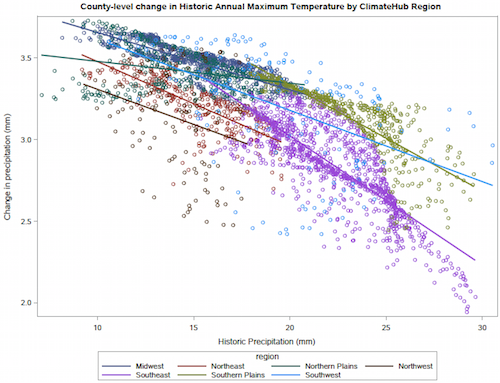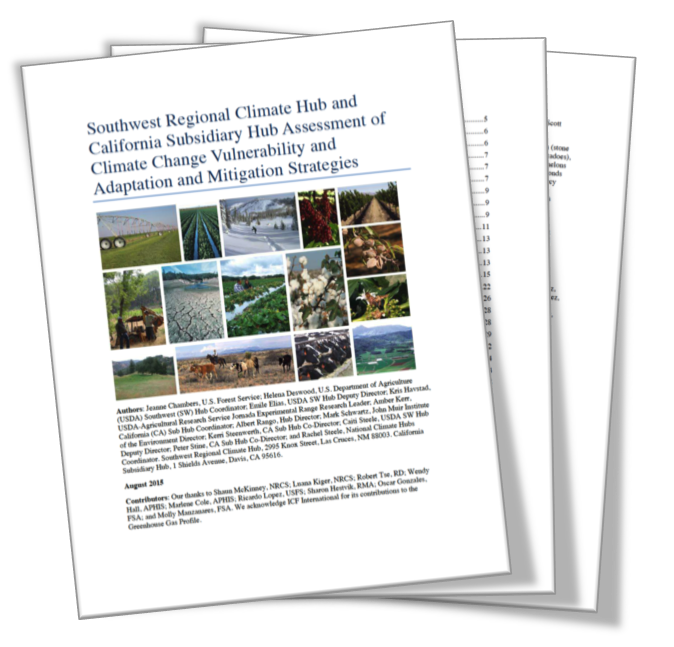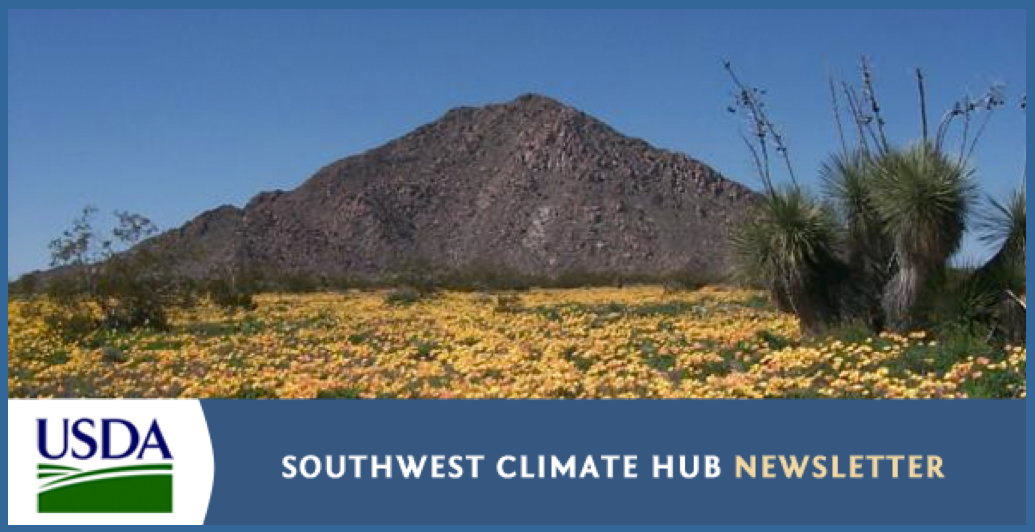- Data
- Videos
-
Publications & Research
-
Education
- Water Conservation Data Jam - Curriculum for 6th-12th Grade Students
- Climate Change and Wildfire – Curriculum Unit for 9-12 Grade Students
- Climate Change and the Carbon Cycle – Curriculum Unit for 9-12 Grade Students
- Where's Our Water? Water Conservation in the Southwest - Lesson for 6-8 Grade Students
- Climate Change and the Water Cycle - 10-Hour Curriculum Unit for 6-12 Grade Students
- The Effects of Climate Change on Agricultural Systems - 5-Hour Curriculum Unit for 6-12 Grade Students
- Cambio climatico y el ciclo del agua
- Webinars and Online Courses
- Websites
- News & Events
- About Us
- RMA
Climate Change Vulnerability Assessment of Southwestern Agricultural and Forest Systems
Climate Hubs across the nation authored our first vulnerability assessments of regional agriculture and forests to climate change. In the Southwest Region the Southwest Hub and the California Sub Hub collaborated to assess the vulnerability of selected specialty and field crops, rangeland and animal agriculture, and forest systems to climate change. This effort generated ‘building blocks’ for future work. We now have a database of more than 700 articles pertaining to vulnerability of Southwestern agriculture and forest systems. Those articles are being added to a searchable, geospatial, online database called Journal Map. Many crop specialists and extension agents reviewed and added to sections of the vulnerability assessment which led to a new list of experts to help farmers and ranchers in adapting to climate change. It was truly a community effort. Here we provide the first excerpt of our assessment introduction as well as several major findings related to the regions crops.
Southwest agriculture’s sensitivity to climate change and adaptation strategies
Scientists predict with high confidence that temperatures in the Southwestern U.S. will increase in coming decades. Agriculture, a $55B industry in 2012 across this six state region of California, Hawaii, Arizona, Nevada, Utah, and New Mexico, is impacted by temperature increases. This report details potential impacts to specialty crops, field crops, forests, and animal agriculture. California produces many high-value specialty crops not grown elsewhere in the U.S. In this analysis, vulnerability is defined as a function of exposure to climate change effects, sensitivity to these effects, and adaptive capacity. Possible impacts of this increase in both maximum and minimum temperatures are serious. They include substantially reduced capacities to produce forage for livestock, lower yields of specialty and field crops, diminished quality and quantity of particularly temperature sensitive crops such as corn and wheat, a shifting of suitable crop distribution and increased severity of forest fires, indirect effects of climate change related to the health and quality of soil and water resources, as well as economic and social health of the region.
Several overall findings are described below:
Southwestern agriculture is defined by water availability.
More than 92% of the region’s cropland is irrigated, and agricultural uses account for 79% of all water withdrawals in the region (Kenny et al. 2009). Understandably, the amount of water used by agriculture varies regionally. A warmer, drier climate increases attempts to transfer large amounts of irrigation water to urban areas, which directly impacts local agriculture and associated communities. Water availability may drive transformational shifts. In some locations, current irrigated acres may shift to rainfed agriculture. In other locations, rainfed agriculture may no longer be economical. In rainfed rangelands, there are few, if any, management alternatives to maintain current ecosystem services.
Rising temperatures and shifting precipitation patterns, especially in the southern portion of the region, will alter crop-water requirements, crop-water availability, crop productivity, and costs of water access. Higher temperatures will increase losses from both evaporation and transpiration. The resulting shift in crop health will, in turn, drive changes in cropland allocations and production systems. High nighttime temperatures effectively increase the minimum temperatures. Temperature increases result in more precipitation occurring as rain rather than snow and earlier snowmelt runoff, possibly leading to irrigation scheduling and water use challenges.
Elevated temperatures are associated with reduced yields in some crops. For grain crops, high nighttime temperatures during the grain-filling period increases the rate of grain-filling and decreases the length of the grain-filling period, resulting in reduced grain yields. Perennial specialty crops have a winter chilling requirement ranging from 200 to 2,000 cumulative chill-hours. Yields decline if the chilling requirement is not completely satisfied, because flower emergence and viability is low. Winter chill periods are projected to fall below the duration necessary for many California trees to bear nuts and fruits, which will result in lower yields. Projections show that chilling requirements for some fruit and nut trees in California will not be met by the middle to the end of this century (Luedeling 2012, Luedeling, Zhang, Luedeling, et al. 2009). In 2012, fruit, tree nuts and berries accounted for $17.9B in sales, the largest revenue from a commodity group in the Southwest.
The assessment summarizes the 14 most economically important and regionally valuable specialty crops. Here we provide the excerpt on California almond production written by Amber Kerr of the Sub Hub and reviewed by Greg Browne, Dan Kluepfel, and Dianne Velasco (UC Davis).
Almonds
Almonds were a $5B industry in 2012, approximately double their value only a decade earlier. California currently produces 100% of the nation’s commercial almond crop and more than 80% of the world’s almond crop (Almond Board of California 2013). Although often considered together with other tree nuts such as walnuts and pistachios, almonds are very closely related to stone fruit (e.g., peaches, plums, apricots, cherries; all in the genus Prunus). The majority of almonds in California are grafted onto peach (P. persica) or peach-almond hybrid rootstock (Doll and DeBuse 2011).
Almonds are native to the Middle East and Central Asia; they thrive on cool (but not frosty) winters and warm, dry summers (Starrs and Goin 2010). In California, they are almost exclusively grown in the Central Valley. Most almond varieties require only 200-400 annual chill hours (hours below 7.2°C (45°F)) for optimal yields, less than most other stone fruit. Almonds depend upon bees for pollination (with the exception of a very few recently released self-pollinating almond cultivars). When California’s almonds bloom in early spring, they require more than half of all the commercially operated beehives in the United States (many of which are trucked in from great distances).
Vulnerability of almonds under a changing climate
|
Exposure |
Sensitivity |
Adaptive Capacity |
|
|
|
Water: Despite intense recent media attention on the water use of California almonds during the current drought (Holthaus 2014, Thomas 2014), almond farmers are not wasteful water users. The average California almond orchard uses about 40 inches of irrigation water per year (UC ANR 2014), which is similar to other fruit and nut orchards and which represents a one-third reduction compared to 20 years ago. These reductions are thanks to techniques such as microsprinkler and drip irrigation and monitoring of crop evapotranspiration and soil moisture (Almond Board of California 2014). Almond farmers sometimes have to use deficit irrigation, a drought survival strategy that reduces irrigation by applying water during vital phonological stages at the expense of more drought-tolerant stages. While this reduces yields, it allows trees to survive and continue producing until more water becomes available (UC ANR 2014).
Temperature: The question of how almonds will respond to warmer temperatures has attracted much research in recent years. Luedeling et al. (2009) predicted trends in decreasing chill-hours in the Central Valley and concluded that almonds were only slightly vulnerable, as they have more modest chilling requirements than other stone fruit (about 200-400 hours, whereas others generally require 500-1000). Luedeling et al. predicted that many suitable almond growing locations would remain by mid- to late-century. The extent of winter fog loss is an important and unknown variable in this question (Baldocchi and Waller 2014).
Lobell and Field (2011) went beyond a simple analysis of the chill-hour threshold and noted that almond yields seem to be inversely related to February nighttime temperatures. They proposed that warm February temperatures shorten the blooming window and hamper pollination. However, in their analysis, the benefits of warmer springs and summers partly canceled out the negative yield effects of warmer winters, for an overall yield reduction of about 10% by 2030 in the absence of adaptation.
Other factors: Because almonds depend on bees for pollination, any factor that harms bees – whether climate-related or not – can harm almond yields. Bee populations have crashed in recent years due to a poorly understood combination of diseases, parasites, pesticides, and possibly other factors; now, in California, drought has curtailed bees’ food supply (Quinton 2014). Encouraging native pollinators may be a helpful management strategy to supplement pollination by honeybees (Kremen 2013).
Almonds are vulnerable to severe storm events, especially while flowering. A severe rain or hailstorm during peak bloom can devastate the year’s crop. In older almond orchards, high winds can cause widespread lodging (tipping over) of trees. Furthermore, warm storms that deliver large amounts of rain – expected to become more common with climate change – are known to be correlated with severe fungal disease in almonds, such as shot hole and brown rot (Campbell 2006).
References
Almond Board of California. 2013. 2013 Almond Almanac. Modesto, CA: Almond Board of California. 42. Available at http://www.almonds.com/sites/default/files/content/attachments/2013_alma....
Almond Board of California. Almond farmer recognized for water stewardship. Available at http://www.almonds.com/newsletters/outlook/almond-farmer-recognized-wate... (Accessed December 2, 2014).
Baldocchi, D.D.; Waller, E. 2014. Winter fog is decreasing in the fruit growing region of the Central Valley of California. Geophysical Research Letters. 41(9): 3251-3256.
Campbell, K. Weather taunts almond crop, but damage unknown: California Farm Bureau Federation. Available at http://www.agalert.com/story/?id=542 (Accessed December 12, 2012).
Doll, D.; DeBuse, C. Almond rootstocks: UC Davis. Available at http://fruitsandnuts.ucdavis.edu/almondpages/Almond_Rootstocks/ (Accessed January 23, 2015).
Holthaus, E. 2014. The Thirsty West: 10 Percent of California’s Water Goes to Almond Farming. Slate, May 2014. Available at http://www.slate.com/articles/technology/future_tense/2014/05/_10_percen.... (Accessed October 17, 2014).
Kenny, J.F.; Barber, N.L.; Hutson, S.S.; Linsey, K.S.; Lovelace, J.K.; Maupin, M.A. 2009. Estimated Use of Water in the United States in 2005. USGS Circular 1344. 52.
Kremen, C. 2013. Integrated crop pollination for resilience against climate change (and other problems). CDFA Climate Change Consortium, March 21, 2013; Sacramento, CA.
Lobell, D.; Field, C. 2011. California perennial crops in a changing climate. Climatic Change. 109(1): 317-333.
Luedeling, E. 2012. Climate change impacts on winter chill for temperate fruit and nut production: A review. Scientia Horticulturae. 144(0): 218-229.
Luedeling, E.; Zhang, M.; Girvetz, E.H. 2009. Climatic Changes Lead to Declining Winter Chill for Fruit and Nut Trees in California during 1950–2099. PLoS ONE. 4(7): e6166.
Luedeling, E.; Zhang, M.; Luedeling, V.; Girvetz, E.H. 2009. Sensitivity of winter chill models for fruit and nut trees to climatic changes expected in California's Central Valley. Agriculture, Ecosystems & Environment. 133(1–2): 23-31.
Quinton, A. 2014. California Beekeepers Receive Disaster Assistance. Capital Public Radio, November 24, 2014. Available at http://www.capradio.org/articles/2014/11/24/california-beekeepers-receiv.... (Accessed December 9, 2014).
Starrs, P.F.; Goin, P. 2010. Field Guide to California Agriculture. Berkeley, CA: University of California Press: 475 p.
Thomas, M. 2014. California dairy farmers are going nuts for almonds, but at what cost? Grist, September 14, 2014. Available at http://grist.org/food/california-dairy-farmers-are-going-nuts-for-almond.... (Accessed September 18, 2014).
UC ANR. Crop Irrigation Strategies: Individual Crop Deficit Irrigation Information. Oakland, CA: University of California Division of Agriculture and Natural Resources,. Available at http://ucmanagedrought.ucdavis.edu/Agriculture/Crop_Irrigation_Strategies/ (Accessed December 13, 2014).










